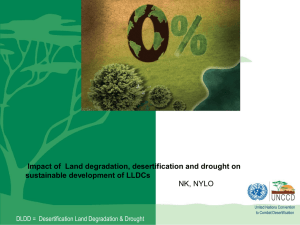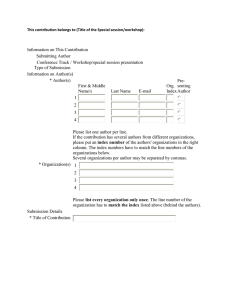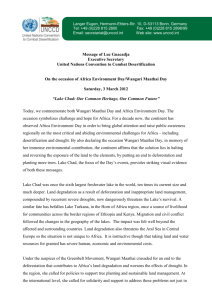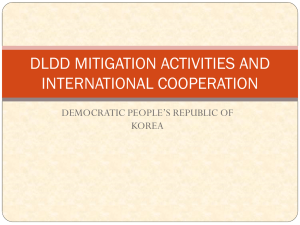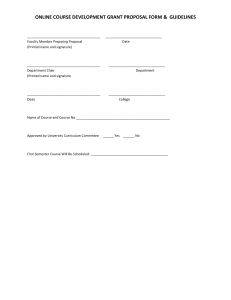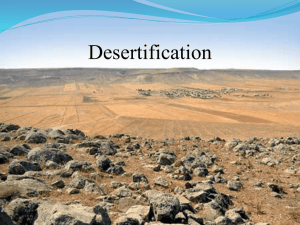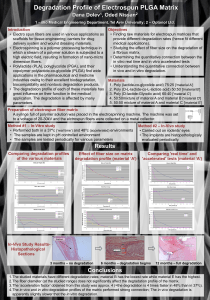presentation
advertisement
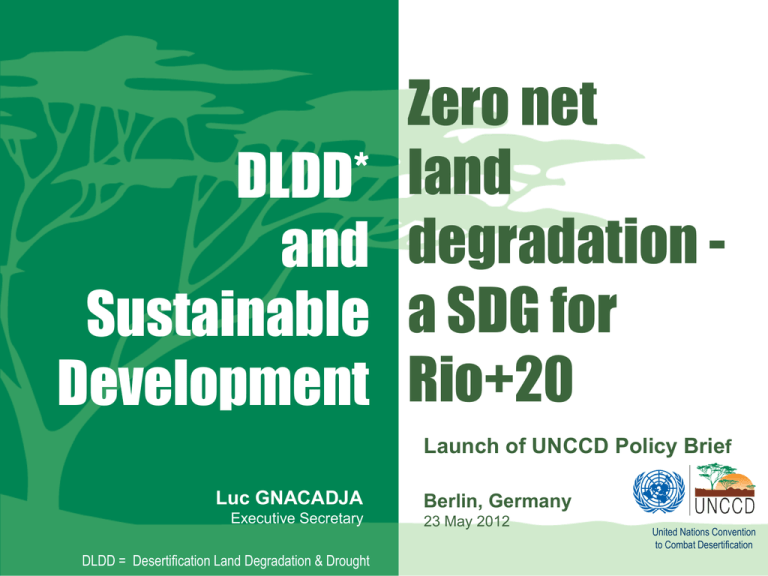
DLDD* and Sustainable Development Zero net land degradation a SDG for Rio+20 Launch of UNCCD Policy Brief Luc GNACADJA Executive Secretary DLDD = Desertification Land Degradation & Drought Berlin, Germany 23 May 2012 United Nations Convention to Combat Desertification 2030: Cropland expansionfor for What implications food, feed and fuel demand 175 to 220 million ha ? 70% rural Sustainable Development Poverty Food security 80% hunger rural +50% in 2030 + 120 million ha Land/Soil For Agricult-Forests Biodiv-Settlements & Infrastructure in 2030 +40% Energy Water Water in Agric 70% in 2030 +40% Deforestation: 70 to 80 % of expansion of cropland expansion lead to deforestation In too many places, achievements in production have been associated with management practices that have degraded the land and water Status & Trends in Global Land Degradation Source: SOLAW 2011 - FAO DLDD: Some facts & figures ? Sustainable Development Food Energy Water Forest Land /Soil Climate Change More than 50% of agricultural moderately to severely degraded LD directly affects 1,5 billion people globally 75 billion tons of fertile soil disappear/year 12 million ha/Year lost due to drought and desertification Six million km2 of drylands bear a legacy of desertification Biodiversity: 27,000 species lost each year due to LD 70 to 80 % of expansion of cropland lead to deforestation DLDD Biodiversity loss Extreme Poverty Food insecurity & Hunger Increased emissions of GHG Deforestation Increased to Drought & Water stress Biodiversity Loss Instability & Crises Migrations DLDD has far-reaching impacts Drought potential worldwide 2000-2098 Source : University Corporation for Atmospheric Research - http://www2.ucar.edu/news/2904/climate-change-drought-may-threaten-much-globe-within-decades DLDD* Drying up The Future We Want United Nations Convention to Combat Desertification DLDD = Desertification Land Degradation & Drought NCCD Climate change will depress agricultural yields in Umost countries by 2050 given current agricultural practices and crop varieties Changes in agricultural productivity by 2050 due to Climate change Source: Müller and others 2009. in WDR 2010, Page 145 Note: The figure shows the projected percentage change in yields of 11 major crops (wheat, rice, maize, millet, field pea, sugar beet, sweet potato, soybean, groundnut, sunflower, and rapeseed) from 2046 to 2055, compared with 1996–2005. The values are the mean of three emission scenarios across five global climate models, assuming no CO2 fertilization (see note 54). Large negative yield impacts are projected in many areas that are highly dependent on agriculture DLDD & Climate Change The % of Earth’s land area stricken by serious drought has more than doubled from the 1970s to the early 2000s Climate change will depress agricultural yields by up to 15-50% in most countries by 2050, given current agricultural practices and crop varieties Agriculture worldwide accounts for around 15% of global greenhouse gas emissions. The related deforestation contributes about 11% “Improved management of the world’s land (including terrestrial carbon) represents one third of the overall global abatement potential in 2030 (and a half in 2020)1. It represents 7Gt CO2e of mitigation in developing countries in 2020, roughly 40% of the 17Gt CO2e of mitigation required globally” No Carbon neutrality without Land degradation neutrality Source: World Resources Institute, South Dakota State University, the IUCN and the Global Partnership on Forest Landscape Restoration http://www.wri.org/map/global-map-forest-landscape-restoration-opportunities Intervention Options for ZNLD Type 1 – High degradation trend or highly degraded lands: 25% Rehabilitate if economically feasible; mitigate where degrading trends are high Type 2 – Moderate degradation trend in slightly or moderately degraded land: 8% Introduce measure to mitigate degradation Type 3 – Stable land, slightly or moderately degraded: 36% Preventive interventions Type 4 – Improving lands: 10% Reinforcement of enabling conditions which foster SLM Source FAO SOLAW 2011 UNCCD Cost of Action Vs Inaction The Economics of Land Degradation For a SDG on Land @ Rio + 20 Land Degradation Neutral World Food Energy Forest Gender Migration Water SLM Land /Soil DLDD Climate Change Biodiversity loss Sustainable land use for all and by all (in agriculture, forestry, energy, urbanization Improving Ecosystems Improving Livelihoods Reversing Land Degradation Targets: • ZNLD by 2030 • ZNFD by 2030 • Drought preparedness in all droughts prone countries by 2020 Efficiency Resilience Inclusiveness Poverty eradication Improving livelihood through pro-poor policies on Sustainable Land & Water Management Food Security Preserving the resource base for food security – Land productivity/Soil fertility improvement at the core of all long term strategies Climate change Land is a win-win context for adaptation, mitigation & resilience building Avoided Deforestation Sust. Land Management & Restoration of degraded Lands as an alternative to Deforestation Drought & Water stress Improving water availability & quality through sustainable land & water management Biodiversity LD Neutrality Biodiversity conservation through improvement of land ecosystems’ conditions Bio Energies Avoiding Forced Migrations Opportunities for Bio energies through biomass production Changing the DAM paradigm “Degrade-Abandon-Migrate” Thank you

